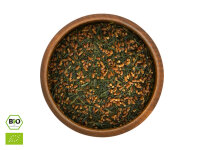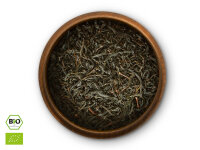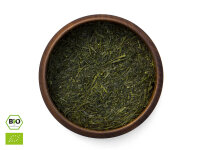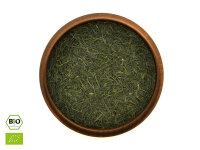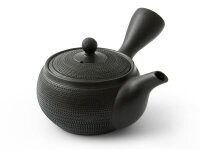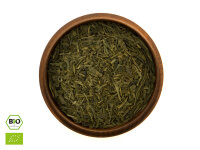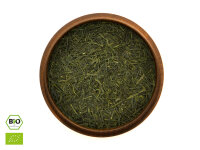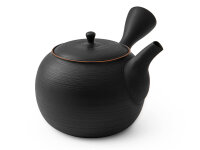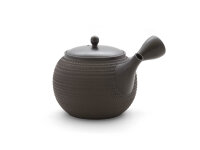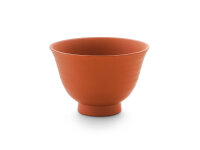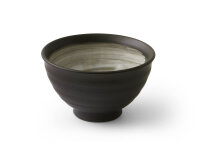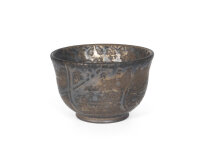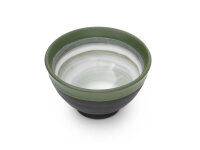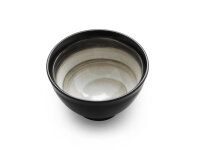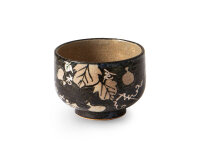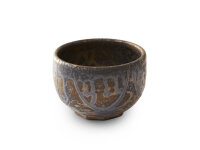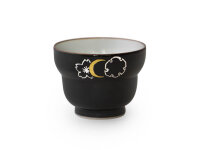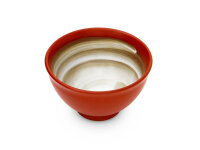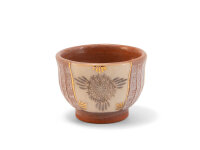"Tea bowl Sendan Kuro"
Gyokko - the master of pottery
When it comes to the small teapots Kyusu, he is one of the greats. Master Gyokko has won numerous awards for his sensitive, delicate craftsmanship: Japan Sencha Art, Choza-Sho Pottery Exhibition, Encourage Prize, the Award of "Excellent Craftsmen" and others. His works boast beautiful shapes, impeccable craftsmanship, and intricate details. All of Gyokko's Kyusu teapots are hand-formed by him on the potter's wheel. Additionally, the art of "baking," i.e., firing the pottery, stands out. Gyokko is unparalleled in mastering the "reduction firing," with which he creates his distinctive, iridescent shades. In some of his pieces, he achieves remarkably vivid color plays and gradients, while others showcase a color consistency exemplary for unique items. The clay required for this, with its high iron content, is a pure natural product: shudei, a red clay rich in iron. Moreover, Gyokko's pottery is also practical: to ensure comfortable tea pouring, Gyokko incorporates a ceramic sieve with over 400 hand-pierced holes, which tea aficionados value more than stainless steel sieves.
Clay teapots: characteristics, origin, and firing method are closely related
The four most prominent regions where Japanese clay teapots were crafted are Mie Prefecture (Banko Yaki), Gifu (Onko Yaki), Aichi Prefecture (Tokoname Yaki), and Sado Island, Niigata Prefecture (Mumyoi Yaki). These areas all have clay deposits rich in minerals. Production of Japanese clay teapots, known as Onko Yaki, began in Ogaki only in the 19th century. Although this production has ceased, the technique of crafting Japanese teapots from clay on the potter's wheel, introduced by Ogaki, remains. Especially in the most renowned regions - predominantly Tokoname, followed by Yokkaichi in Mie Prefecture - Japanese clay teapots continue to be hand-formed on the potter's wheel by esteemed artisans. The primary firing methods employed are reduction firing and oxidation firing. Teapots made with the reduction firing method have a slightly attenuating to neutral character and suit all types of green tea, while those made using oxidation firing tend to accentuate the various flavors of green tea.
Tokoname yaki, Japanese teapots from Tokoname
Tokoname is the most famous and largest among the ancient kilns for clay production, with its esteemed reputation reaching well beyond Japan's borders. In the diverse range of clay products, Japanese teapots play a pivotal role. A red, natural clay, Shudei, is sourced from Tokoname. The varied colors of teapots made from this red clay arise from the firing method employed, either reduction or oxidation firing, and the oxygen levels during the firing process. The clay reacts very sensitively during this process, ensuring only those artisans with significant experience and finesse can craft high-quality products. The history of Tokoname is steeped in antiquity. As early as the 12th century, the kiln began operations, marking it as one of Japan's oldest. Initially, Tokoname used white clay from rice fields. However, around 1954, Sugie Jyumon, in collaboration with a doctor named Hirano Chuji, realized that Tokoname's natural red clay had an exceptional mineral composition, cementing the significance of red clay. A unique decorative style emblematic of Tokoname teapots is the Mogake technique. Invented by Ina Chozo, this method involves covering teapots with seaweed prior to firing. During the firing, the minerals in the seaweed and clay interact, resulting in singular patterns on the teapot's surface.
The advantage of natural clay
The distinction between natural and mixed clay lies in the iron's form: in natural clay, the iron is crystallized. In clay where iron is "artificially" incorporated, the iron is pre-ground. This leads to a distinct, uneven, and more extensive surface, and the melting point is substantially lower than natural iron's. This means that tableware made of clay or loam with added iron must be fired at much lower temperatures - around 600-800 degrees. In contrast, Japanese teapots crafted from natural clay can withstand firing temperatures up to 1200 degrees. This not only bolsters the product's durability, but the material transformation also hinges on the temperature. Presently, most clay teapots, especially those mass-produced in China and even in Japan, are made from artificially mixed clay.
Cleaning Note
Cleaning: Rinse both the exterior and interior with only warm water. Avoid using cleaning agents. If needed, cleanse impurities with infused green tea. Regular use results in a tea patina, which doesn't need removal as it bestows the teapot with a distinct character.

